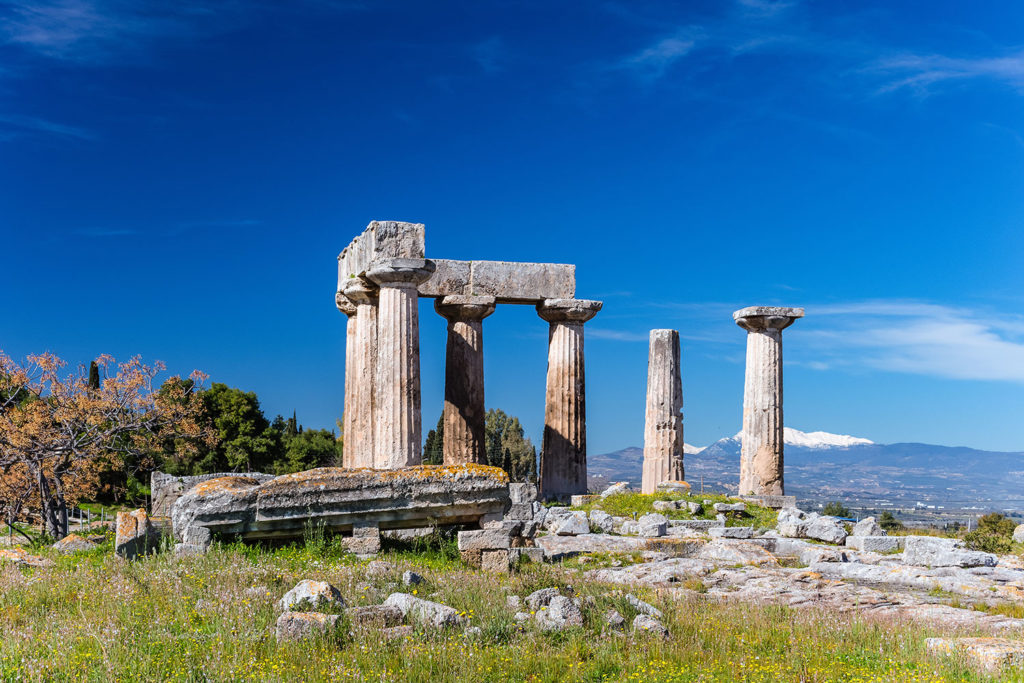By John McRay
The Bible is a collection of many kinds of documents written over a period of about 1,500 years. Beginning with the composition of the first five books (the Pentateuch) by Moses, the 66 total documents were completed by the end of the first century A.D. They were composed in the Hebrew and Greek languages in various geographical settings and different historical periods. Archaeological discoveries relating to these settings and periods have enlightened the cultural context in which many of the recorded events occurred and enhanced the credibility of the Biblical record, both the Old and New Testament periods. For example, many events recorded in the last 100 years of this period of biblical history, during which the New Testament documents were written, have been illuminated through significant archaeological discoveries. Following are some of these impressive finds. Limitations on the length of this article will not allow discussion of the 1,400 years of Old Testament sites.
Pool of Siloam
Hezekiah, a king of Judah in the Eighth century B.C., built a tunnel through Mount Ophel in Jerusalem southward from the underground Gihon Spring through almost 1,750 feet of rock to channel water to the Pool of Siloam inside the city walls. It was to this pool that Jesus sent a blind man to have him wash his eyes in its water and receive his sight, according to John 9:7.
Until recently, only a small portion of the pool has been accessible. After the site was excavated in the late nineteenth century, the people of the village of Silwan (modern spelling of Siloam) built on the northwest corner of the little pool a mosque with a minaret, which still stands above it. However, excavations at the site in the first six months of 2005 have uncovered the eastern portion of a large pool, fifty meters in length, (its width not yet known) which lies only about ten meters south of the little pool. These two are undoubtedly a part of one larger complex that was called the Siloam Pool (like the Pool of Bethesda which had two sections). It has a series of stone steps for entering the pool, which, being fed by fresh running water from the Gihon Spring through a small channel discovered on the north side of the pool, was probably a major facility for ritual purification before entering the temple. This may be the reason Jesus chose this pool for the miracle. A stone pavement has also recently been discovered, leading from the pool up Mt. Ophel to the Temple Mount.
Rolling Stones at Tombs
In Matthew (see 28:2) it is stated that an angel descended from heaven to the tomb of Jesus, “rolled back the stone and sat upon it.” Many tombs from the time of Christ have been discovered in Jerusalem, and some of them still have these rolling stones by their entrances. A tomb from the time of Jesus was built for the burial of Queen Helena of Adiabene north of the Damascus Gate and has the stone still in place. Another, better preserved rolling stone, still stands beside the entrance to the tomb of the family of Herod the Great, south of the King David Hotel. More than 60 rolling stone tombs have been found and studied in Israel and Jordan in recent years.
Tomb of Caiaphas
In November, 1990, a tomb was discovered in Jerusalem that contains an ossuary with the name of Caiaphas carved into it. The burial cave is located in the Peace Forest, south of the Gehenna Valley, near the Government House where the United Nations was located. The high priest before whom Jesus appeared just before his death was named Caiaphas (see Matthew 26:3,57; Luke 3:2; John 11:49; 18:13,14,24,28). Later both Simon Peter and John appeared before him in Jerusalem (Acts 4:6). Archaeologists have identified the site as the burial cave of the family of Caiaphas.
Capernaum Synagogue
When Jesus began his public ministry in Nazareth of Galilee at about 30 years of age and was rejected in the synagogue there (see Luke 3:23; 4:16-30), he went to Capernaum, a small village on the north shore of the Sea of Galilee, where he apparently lived in the home of Simon Peter, one of his disciples (see Matthew 8:14; Mark 2:1), and taught in the synagogue (see Mark 1:21; 3:1; John 6:59). Archaeological excavations conducted in Capernaum have discovered the synagogue under the fourth/fifth century limestone structure still standing there. Portions of the floor and walls of the first century synagogue were found beneath the floor of this later building.
Acts 17:6 and Politarchs in Thessalonica
The credibility of the Bible has been challenged for many years by critics who have insisted that Luke, the author of the Acts of the Apostles, erroneously used the Greek term Politarch in referring to the officials before whom Christians associated with the apostle Paul were taken in the city of Thessalonica (see Acts 17:6). It has been adamantly asserted that no such office existed at that time. However, an inscription containing this term has been found in that city and is now displayed in the British Museum. The inscription, which was attached to a first century arch on Egnatia Street, begins “In the time of the Politarchs…” Thirty-five inscriptions have now been discovered which contain this term; nineteen of them come from Thessalonica, and at least three date to the first century A.D. These inscriptions prove that the office of politarchs existed in Thessalonica in the time of the New Testament and that the Bible is accurate in its use of the term.
Erastus in Corinth
Before A.D. 50, a 62 foot square area was paved with stone at the northeast corner of the theater in Corinth, Greece. Excavations there revealed part of a Latin inscription carved into the pavement which reads: “Erastus in return for his aedileship laid (the pavement) at his own expense.”
The Erastus of this inscription is identified in the excavation publication as the Erastus mentioned by Paul in Romans 16:23, a letter written from Corinth, in which Erastus is referred to as “the city treasurer.” Three main points favoring the identification are set forth by the editor of the inscriptions: 1) the pavement was laid around A.D. 50, the time when Erastus would likely have been converted; 2) the name Erastus, an uncommon cognomen, is not found in Corinth other than in this inscription; 3) the particular Greek word used by Paul in this passage for “treasurer” (oikonomos) is an appropriate term to describe the work of a Corinthian aedile.
Romans 13:3 Inscription in Caesarea Maritima
While I was excavating at Caesarea on the coast of Israel in 1972, we uncovered a large mosaic inscription of the Greek text of Romans 13:3. A shorter one had been found in 1960 by an Israeli archaeologist, Abraham Negev. The two texts, dating to at least the fifth century, are part of a mosaic floor of a large public building (perhaps a praetorium or archives building) and are identical to that passage in the Greek New Testament. These are as old as some of our oldest manuscripts of the New Testament.
Paul before Gallio at the Tribunal in Corinth
One of the most important discoveries relating to the New Testament is the tribunal (Greek bema), or speaker’s platform, from which official proclamations were read, and where citizens appeared before appropriate officials. It still stands in the heart of the forum in Corinth, Greece. The large stone platform was identified by portions of an inscription found nearby and dated to the period between A.D. 25 and 50, just prior to Paul’s arrival in the city.
Paul spent 18 months in Corinth on his second missionary journey. At the end of that time, the Jews took advantage of the inauguration of Gallio as proconsul of Achaia in May or June of 51 A.D. (see Acts 18:12) to bring Paul before him on the charge of violating their law. Gallio found no violation of Roman law by Paul, no “wrongdoing or vicious crime (see Acts 18:14), and refusing to be a judge of Jewish law, drove Paul’s accusers from this “tribunal” (see Acts 18:16-17), where he was seated. Gallio was the brother of Seneca, a Greek stoic philosopher who later became an adviser to the emperor Nero. Seneca perhaps informed the emperor of the fact that Paul had already been acquitted before Gallio in Corinth and thus influenced the favorable outcome of Paul’s first arrest in Rome as implied in the last verses of Acts. Luke’s accuracy in referring to this tribunal once again enhances the accuracy of the Bible.
Gallio was visiting Corinth from his official residence in Delphi across the Corinthian Gulf. Four fragments of an inscription carved in stone which had been mounted on the wall of a public building in Delphi have been excavated, which contain information about the accession of Gallio and help to determine the date of his tenure in office.
The fragments are from a copy of a letter sent from Claudius to the city of Delphi, either to the people of Delphi or to the successor of Gallio, who had the letter carved into stone and attached to the wall of the building. It contains the name of “Gallio Proconsul of Asia”, in addition to that of the Roman emperor Claudius, with dates for his reign.
The letter is dated to A.D. 52. Since proconsuls normally held office for one year, and these provincial governors were required to leave Rome for their posts no later than the middle of April, Gallio probably began his term of office in May of A.D. 51. And since Paul had arrived in Corinth 18 months earlier than his appearance before Gallio (see Acts 18:11-12), he would have entered Corinth in the winter of 49/50-perhaps in January of A.D. 50.
This would coincide well with Luke’s statement in Acts 18:2, that when Paul arrived in Corinth on his second journey, he found Aquila and Priscilla, Jews who had “recently” come from Rome, “because Claudius had commanded all the Jews to leave Rome.” This expulsion is also referred to in other ancient sources and can be dated to A.D. 49. Suetonius, chief secretary to the emperor Hadrian (A.D. 117-38), wrote a biographical account of the Roman emperors entitled The Twelve Caesars, in which he said, “Because the Jews at Rome caused continuous disturbances at the instigation of Christ, he expelled them from the City” (see Claudius 25.4). Thus, the accuracy of Luke’s account in Acts is confirmed and illustrated.
Published March 30, 2016




